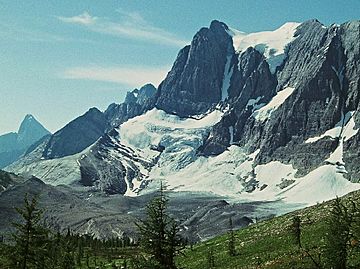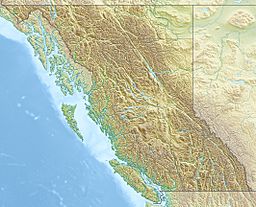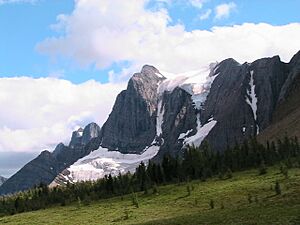Tumbling Peak facts for kids
Quick facts for kids Tumbling Peak |
|
|---|---|

Tumbling Peak and Tumbling Glacier seen from the Rockwall Trail
|
|
| Highest point | |
| Elevation | 3,145 m (10,318 ft) |
| Prominence | 685 m (2,247 ft) |
| Parent peak | Foster Peak (3145 m) |
| Geography | |
| Location | Kootenay National Park British Columbia, Canada |
| Parent range | Vermilion Range Canadian Rockies |
| Topo map | NTS 82N01 |
| Geology | |
| Age of rock | Cambrian |
| Type of rock | Ottertail Limestone |
Tumbling Peak is a tall mountain, standing 3,145 meters (about 10,318 feet) high. It's found on the western edge of Kootenay National Park in British Columbia, Canada. It's part of the Canadian Rockies, specifically a smaller group of mountains called the Vermilion Range.
The mountain gets its name from the Tumbling Glacier, a large ice field on its northeast side. Its closest taller neighbor is Foster Peak, about 6.8 kilometers (4.2 miles) away to the southeast. Hewitt Peak is also nearby to the southeast, and Mount Gray is just to the northwest.
Tumbling Peak is part of a famous area called the Rockwall. This is a huge, steep cliff face in the Vermilion Range. The Rockwall Trail is a beautiful 55-kilometer (34-mile) path. It takes hikers through high mountain passes, green meadows, and past hanging glaciers. Some of the limestone cliffs along the trail are over 900 meters (2,953 feet) tall!
What is Tumbling Peak Made Of?
Tumbling Peak is mostly made of a type of rock called Ottertail Limestone. This rock formed from tiny bits of sea creatures and minerals that settled at the bottom of ancient oceans. Over millions of years, these layers hardened into sedimentary rock.
This rock was laid down during a very long time, from the Precambrian to the Jurassic periods. Later, during a major mountain-building event called the Laramide orogeny, these rock layers were pushed up and over younger rocks. This is how the Canadian Rockies, including Tumbling Peak, were formed.
What is the Weather Like at Tumbling Peak?
Tumbling Peak has a subarctic climate. This means it has very cold and snowy winters. The summers are usually mild. Temperatures can drop below −20 °C (or -4 °F). With the wind, it can feel even colder, sometimes below −30 °C (or -22 °F).
Rain and melting snow from the mountain flow in two main directions. On the east side, the water drains into streams that feed the Vermilion River. On the west side, the water flows into the beginnings of the Kootenay River.




